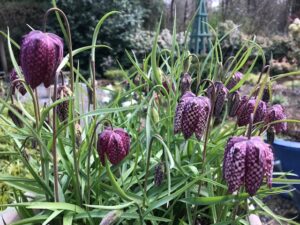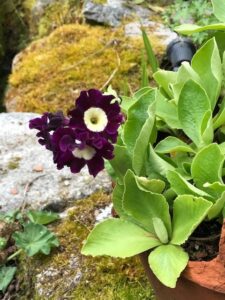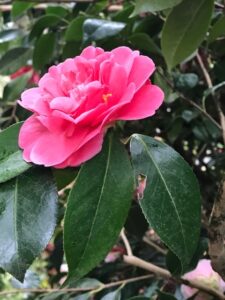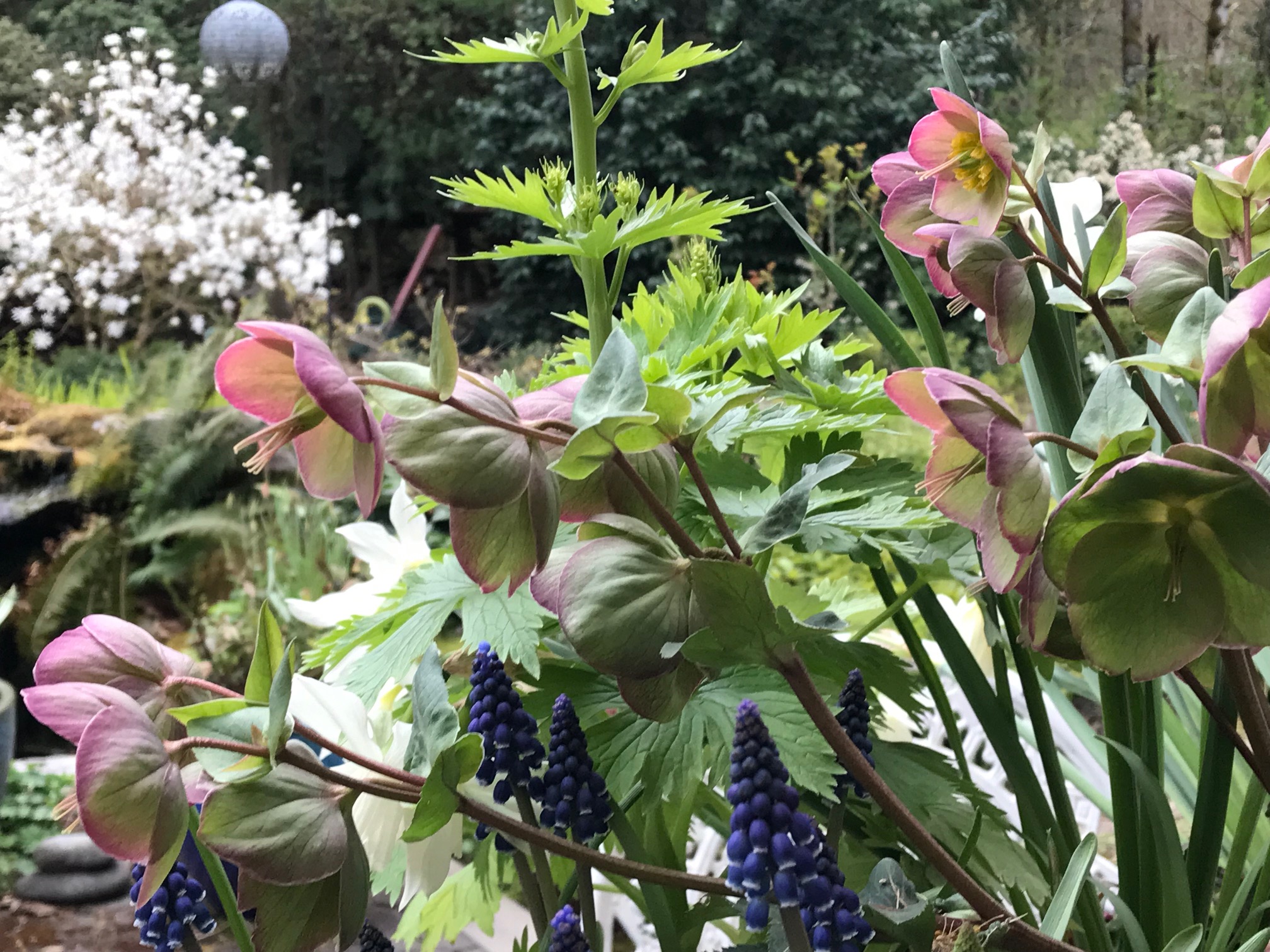AH, SPRING! THIS TIME of year, I walk around with Gerard Manley Hopkins’ lines beating in my head:
Nothing is so beautiful as Spring—
When weeds, in wheels, shoot long and lovely and lush . . .
Though, as a gardener, I always think that if Hopkins had been slightly more earthy and less bookish, he might not have been so ecstatic about weeds! But I can forgive him that because of the sheer gorgeousness of his language—long and lovely and lush—just the rhythm of those words seems to speak of languorous summer days to come.
But before that, Spring, that most welcome and capricious of seasons—seemingly here one moment and gone the next. Last Thursday it was in the high 70s and you would have sworn Spring was here to stay. Today, it’s 48 degrees and hailing. But still, there are flowers and color—the yellows of forsythia and daffodils, that fresh citrusy green of new leaves, the coral pink and palest pink magnolias, the purples and blues of fritillaries, auriculas, and grape hyacinths, and the crisp whites of star magnolia and my favorite Thalia daffodils.
It’s been a season of personal change for my family and me as well. Last weekend, my husband and I helped our kids move into a new apartment, and I find that those fundamental shifts in my day-to-day life require more adjustment than they used to. And five weeks from today, The Walled Garden comes out! I have to share with you that I got the review of my dreams today from Readers Lane. Check it out here.
I’m so grateful—it’s incredibly gratifying when someone actually gets what you’re trying to do!
All of that to say that I don’t have a lot of words of my own to share today, so I’m borrowing some of Hopkins’ words and supplementing with photos of spring flowers from my garden, with their meanings in the Language of Flowers.
First, a brief note on Gerard Manley Hopkins. Born in 1844 in Essex, England and raised in an Anglican family, he converted to Catholicism in 1866 and eventually became a Jesuit priest. He seems to have been tormented by trying to live in the tension (for him) between his religious beliefs and his poetic/artistic side. Early training in drawing and the visual arts directly fed his poetry—you can feel it in his close observations of nature. His poetry was not published until after his death in 1889 at age 44. The playful freshness of his poetic word choices stand in contrast with his somewhat anguished asceticism, as you can feel in the next lines of “Spring”:
Thrush’s eggs look little low heavens, and thrush
Through the echoing timber does so rinse and wring
The ear, it strikes like lightnings to hear him sing;
The glassy peartree leaves and blooms, they brush
The descending blue; that blue is all in a rush
With richness; the racing lambs too have fair their fling.
There’s so much movement and lushness and abundance in those lines—they do what poetry does at its best: create a feeling or an image that goes far beyond mere words.
I don’t have lambs or thrush’s eggs to share with you, but here are a few spring beauties from my garden.

Snakeshead fritillaries, one of my all-time FAVORITE spring flowers. Though their name is wonderfully evocative, they aren’t listed in the Language of Flowers, as much as I wish they were. Their delicate purple checkerboard patterning is just enchanting.

Another one of my spring favorites (sometimes they even bloom a second time in autumn), auriculas mean Painting in the Language of Flowers, which seems appropriate since they always remind me of medieval illuminated manuscripts.

It looks more hot pink in this photo than its true coral pink, but surely, if happiness has a color, it’s this! In the Language of Flowers, magnolias mean Love of Nature.
My friends, I just realized I misidentified my camellia as a magnolia! In the Language of Flowers, Red Camellia Japonica means Unpretending excellence. But it’s the meaning of white camellias that seems especially fitting: Perfected loveliness.
In honor of Easter coming this weekend, let me share with you Hopkins’ beautiful concluding sestet:
What is all this juice and all this joy?
A strain of the earth’s sweet being in the beginning
In Eden garden. Have, get, before it cloy,
Before it cloud, Christ, lord, and sour with sinning,
Innocent mind and Mayday in girl and boy,
Most, O maid’s child, thy choice and worthy the winning.
Happy Spring, my friends! Happy Easter, Happy Passover, and Happy New Beginnings!
(All photos my own)

Lovely post, Robin! Your photos are so gorgeous…. I only wish the fritillaries had a less “evocative” name. 🥺
Thank you, Donna! I know what you mean about fritillaries — I was trying to imagine a good Language of Flowers meaning for them. If they weren’t so beautiful, I’d choose something like “Menace.” Or how about “Cross me at your peril”?!
Beautiful post and beautiful flowers. We are all so starved for color and beauty as we wait for spring to settle in. I agree, the snakeshead fritillaries need to be included in the language of flowers.
Thanks so much, Susan! I agree, we’ll have to come up with our own meaning for fritillaries in the Language of Flowers.
I must thank you for the efforts youve put in penning this site. I am hoping to check out the same high-grade blog posts by you in the future as well. In fact, your creative writing abilities has motivated me to get my very own blog now 😉
I’m delighted you’ve been inspired by my blog! Good luck with your blog — I’m sure it will be great!
What a lovely book review included in this post! I’m counting the days until that book is in my hand.
Thank you, Melody — I was really happy with the review! Only a month now till The Walled Garden will be in your hands . . .